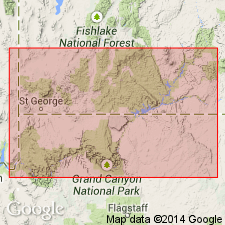
- Usage in publication:
-
- White Throne Member*
- Modifications:
-
- Named
- Dominant lithology:
-
- Sandstone
- AAPG geologic province:
-
- Great Basin province
- Plateau sedimentary province
Summary:
Named as upper member of Temple Cap Sandstone of San Rafael Group for Great White Throne, Zion Canyon, which is about 2 km south of type section and 500 m northeast of Observation Point. Occurs in Paradox basin, Great Basin and Plateau sedimentary provinces. Type section measured in NW1/4 NW1/4 sec 2, T41S, R10W, Washington Co, UT. Is a conspicuous cliff-forming, fine-grained, well-sorted, cross-bedded, light gray, gray-yellow, yellow-orange to reddish-brown sandstone. Is 49.7 m thick at type where it overlies Sinawava Member (new) and unconformably underlies Carmel Formation. Thins eastward. Is beveled out just east of Johnson Canyon, Kane Co by J-2 unconformity. Intertongues with Sinawava and is replaced by Sinawava at Hurricane cliffs. Mapped in earlier papers as part of Navajo Sandstone whereas White Throne is actually an eastward-thinning wedge separated from Navajo by the Sinawava. Assigned to the early and middle Bajocian or Middle Jurassic. Correlates with upper part, Gypsum Spring Member, Twin Creek Limestone of WY and UT. Correlation chart. Cross sections.
Source: GNU records (USGS DDS-6; Denver GNULEX).
For more information, please contact Nancy Stamm, Geologic Names Committee Secretary.
Asterisk (*) indicates published by U.S. Geological Survey authors.
"No current usage" (†) implies that a name has been abandoned or has fallen into disuse. Former usage and, if known, replacement name given in parentheses ( ).
Slash (/) indicates name conflicts with nomenclatural guidelines (CSN, 1933; ACSN, 1961, 1970; NACSN, 1983, 2005, 2021). May be explained within brackets ([ ]).

